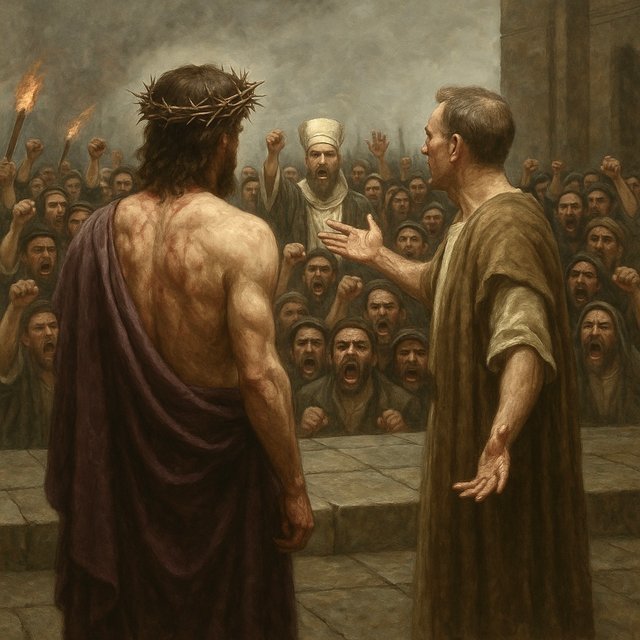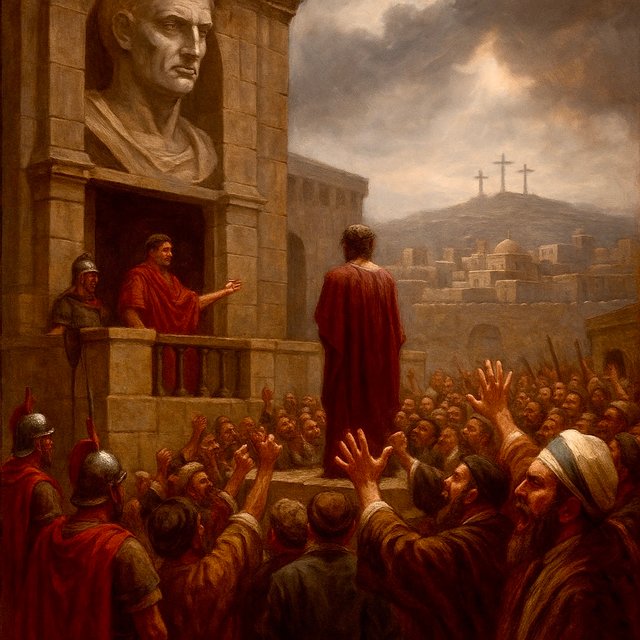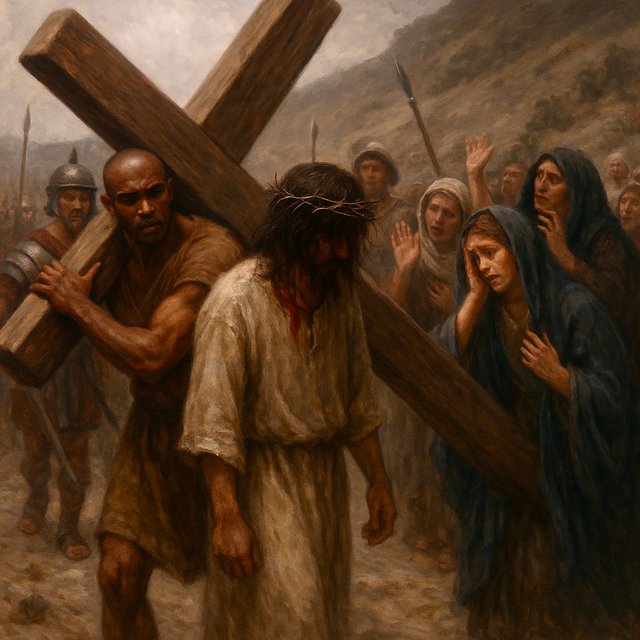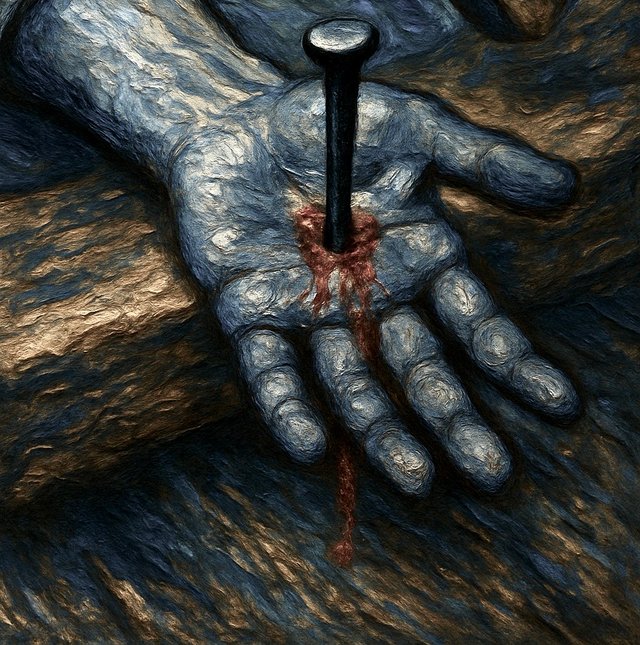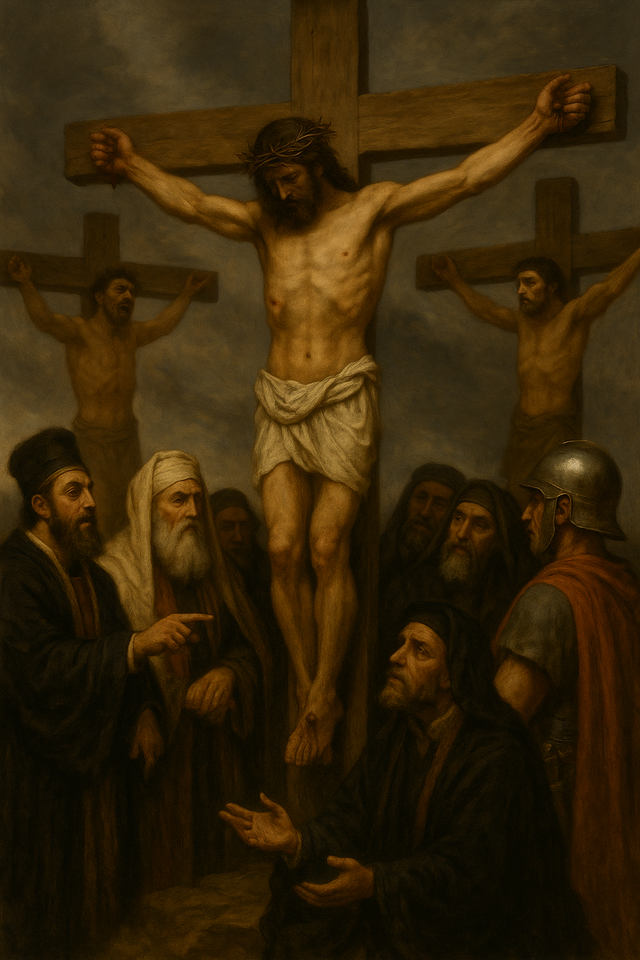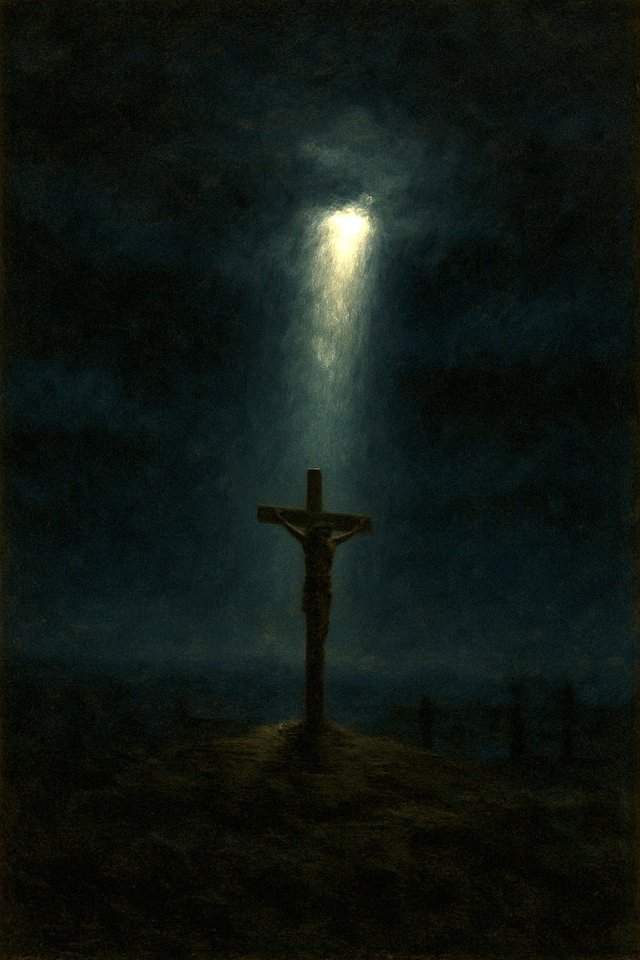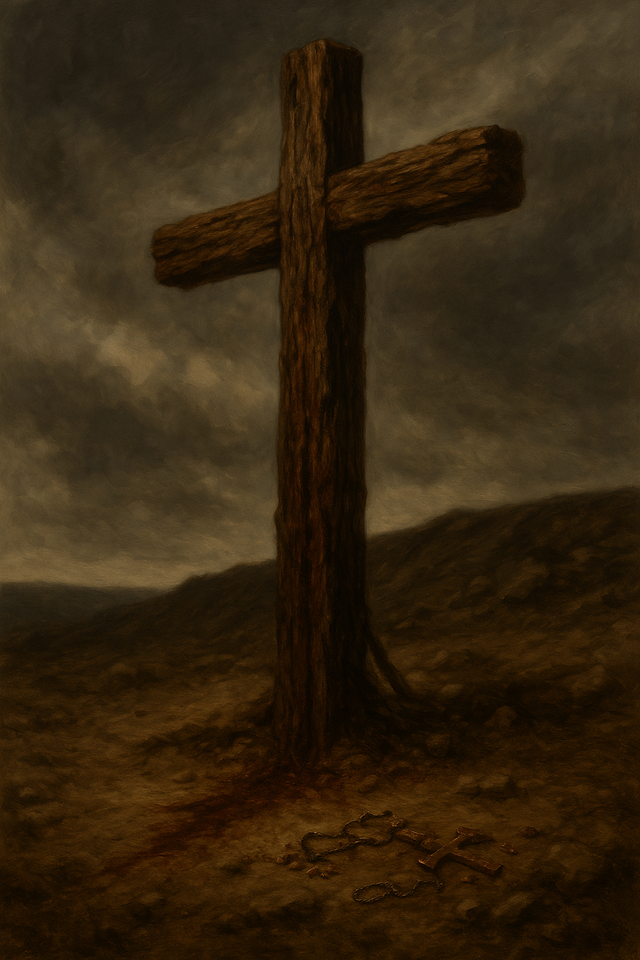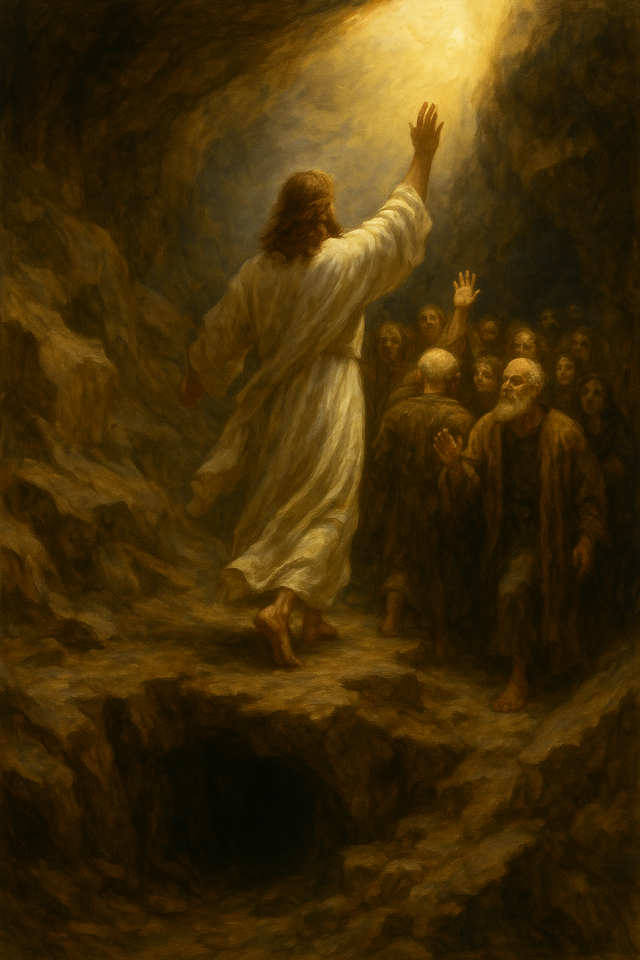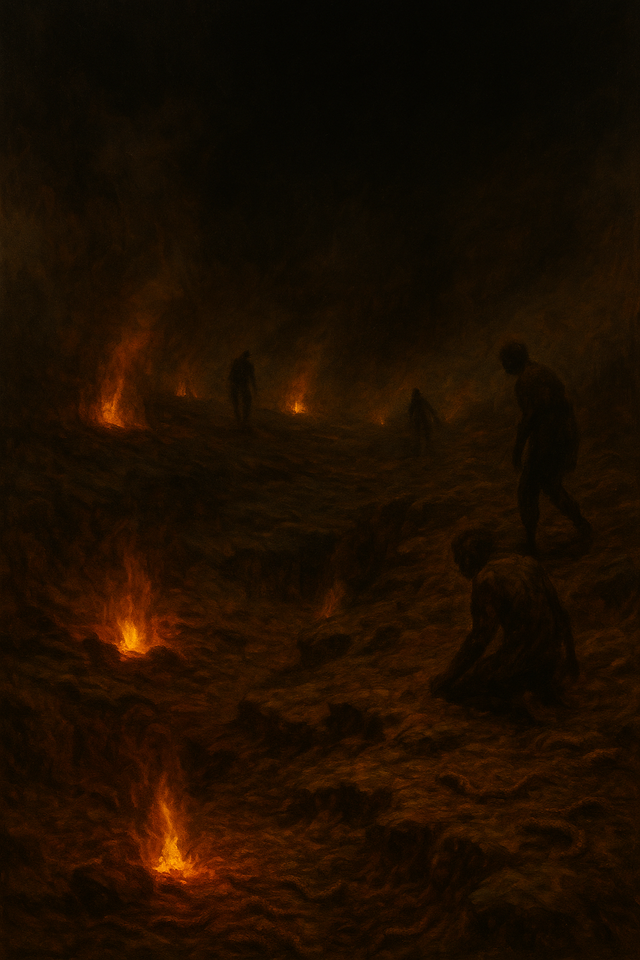Part 3, A Corrected Chronological Walk with Christ
DAY SEVEN — FRIDAY (The Trials, the Crucifixion, and the Burial)
Matthew 26:57–27:66; Mark 14:53–15:47; Luke 22:54–23:56; John 18:12–19:42
⸻
Before Dawn — The Illegal Trials Begin
The night has barely begun to yield to morning.
Jesus has been seized in Gethsemane under the cold kiss of betrayal.
Now He is dragged through a series of secret, unlawful trials —
staged more by rage than justice,
powered more by envy than truth.
• First before Annas — the father-in-law of the high priest (John 18:13).
• Then to Caiaphas and the assembled Sanhedrin (Matthew 26:57–68).
• Then officially at dawn by the full council (Luke 22:66–71).
Luke 22:70–71
“Then said they all, Art thou then the Son of God? And he said unto them, Ye say that I am.
And they said, What need we any further witness? for we ourselves have heard of his own mouth.”
He is condemned — not for crime, but for Truth.
⸻
Morning — Before Pilate and Herod
Bound, bruised, and beaten, Jesus is led to Pontius Pilate.
John 18:29–30
“Pilate then went out unto them, and said, What accusation bring ye against this man?
They answered and said unto him, If he were not a malefactor, we would not have delivered him up unto thee.”
They bring no real charge — only hatred.
Pilate questions Him:
John 18:37
“Art thou a king then?”
Jesus answers:
John 18:37
“To this end was I born, and for this cause came I into the world, that I should bear witness unto the truth.”
Pilate — cynical and blind — shrugs:
John 18:38
“What is truth?”
Unable to find guilt, Pilate sends Him to Herod Antipas, the puppet king.
Herod mocks Him but finds no cause either — and sends Him back.
Pilate offers the crowd a choice:
• Barabbas — a murderer.
• Jesus — the innocent King.
They choose Barabbas.
Scourging, Mocking, and the Crown of Thorns
John 19:1–3
“Then Pilate therefore took Jesus, and scourged him.
And the soldiers platted a crown of thorns, and put it on his head… and said, Hail, King of the Jews!”
The whip tears His flesh.
The thorns pierce His brow.
• The Creator of thorns is crowned with them.
• The King of glory is clothed in mockery.
Pilate presents Him — battered, bleeding:
John 19:5
“Behold the man!”
But the crowd roars:
John 19:6
“Crucify him, crucify him!”
The Final Condemnation — “We Have No King but Caesar”
Pilate, hesitant and fearful, presents Jesus once more:
John 19:14
“Behold your King!”
The priests and rulers — blind with rage — cry out:
John 19:15
“Away with him, away with him, crucify him.”
Pilate asks again:
“Shall I crucify your King?”
And they answer — sealing their own doom:
“We have no king but Caesar.”
With these words,
• they deny their own Messiah,
• they reject their rightful King,
• they choose bondage over blessing,
• they crown their allegiance to the kingdoms of this world.
Their mouths speak judgment.
Their covenant with God is broken by their own lips.
The King is rejected —
the city is condemned —
the clock of destruction begins to tick.
Within a generation,
Jerusalem will fall by the very Caesar they chose over Christ.
Pilate washes his hands — but cannot wash away his guilt.
He delivers Jesus to their will.
“Then delivered he him therefore unto them to be crucified. And they took Jesus, and led him away.”
John 19:16
The Way to the Cross — Bearing His Own Cross
John 19:17
“And he bearing his cross went forth into a place called the place of a skull, which is called in the Hebrew Golgotha.”
Matthew 27:31–32:
“And after that they had mocked him, they took the robe off from him, and put his own raiment on him, and led him away to crucify him.
And as they came out, they found a man of Cyrene, Simon by name: him they compelled to bear his cross.”
• Luke 23:27–31 adds:
“And there followed him a great company of people, and of women, which also bewailed and lamented him.
But Jesus turning unto them said, Daughters of Jerusalem, weep not for me, but weep for yourselves, and for your children.”
Weakened from scourging, begins to carry his cross .. He stumbles.
Simon of Cyrene is compelled to bear the cross behind Him.
Women weep — but He tells them:
Luke 23:28
“Weep not for me, but weep for yourselves, and for your children.”
He walks steadily toward death.
The Third Hour — Crucified Between Two Thieves
Mark 15:25
“And it was the third hour, and they crucified him.”
The nails are driven into his Hands And His Feet
Psalms 22:16
The cross is lifted.
Over His head: “JESUS OF NAZARETH THE KING OF THE JEWS” —
written in Hebrew, Greek, and Latin.
The Jewish Leaders mock:
• “If thou be the Son of God, come down.”
• “He saved others; himself he cannot save.”
But the thief beside Him sees deeper:
Luke 23:42–43
“Lord, remember me when thou comest into thy kingdom.
And Jesus said unto him, Verily I say unto thee, To day shalt thou be with me in paradise.”
Mercy flows even from the cross.
The Sixth to the Ninth Hour — Darkness Covers the Land
Luke 23:44–45
“And it was about the sixth hour, and there was a darkness over all the earth until the ninth hour.”
The Prophetic Fulfillment — Darkness and the Cutting Off of Messiah
Luke 23:44–45
“And it was about the sixth hour, and there was a darkness over all the earth until the ninth hour.
And the sun was darkened…”
At the moment when the sun should have stood brightest,
the heavens went black.
This was not coincidence.
It was prophecy fulfilled.
Seven centuries earlier, the Lord had spoken through Amos:
Amos 8:9
“And it shall come to pass in that day, saith the Lord GOD, that I will cause the sun to go down at noon, and I will darken the earth in the clear day.”
Five centuries earlier, through Daniel, the Lord had declared:
Daniel 9:26
“And after threescore and two weeks shall Messiah be cut off, but not for himself…”
The day had come.
• The sun refused to shine.
• The earth mourned.
• The feasts turned into lamentation.
• And the Messiah was cut off — not for Himself, but for the sins of the world.
If not Jesus — then who?
Who else:
• Appeared exactly at the appointed time,
• Was hailed and then rejected by His own people,
• Was slain amid supernatural darkness,
• And fulfilled the prophets to the letter?
There is no other.
Christ, and Christ alone, stands at the crossroads of prophecy and fulfillment —
the Lamb slain, the King rejected, the Son given.
And so……
The sun refuses to shine.
Creation groans as its Maker is slain.
The Tender Care — “Behold Thy Son”
The darkness covers the land.
The earth shudders.
The sun refuses to shine.
The veil trembles unseen behind the Temple walls.
Yet in the midst of cosmic upheaval,
Jesus sees His mother —
and speaks tenderly from the cross.
John 19:25–27
“Now there stood by the cross of Jesus his mother, and his mother’s sister, Mary the wife of Cleophas, and Mary Magdalene.
When Jesus therefore saw his mother, and the disciple standing by, whom he loved, he saith unto his mother,
Woman, behold thy son!
Then saith he to the disciple,
Behold thy mother!
And from that hour that disciple took her unto his own home.”
The Son, in His dying moments, fulfills the law of love:
• He honors His mother.
• He provides for her future.
• He entrusts her not to earthly kin alone, but to a faithful disciple.
Mary had once cradled Him in her arms —
now He entrusts her to arms that would continue His love.
The Lamb is slain —
but the love of God endures.
And look on and listen carefully…
At the height of His agony, Jesus cries:
Matthew 27:46
“My God, my God, why hast thou forsaken me?”
Psalm 22:1
He thirsts, He suffers like any man would suffer in that situation, he is like you and I, and yet without sin and he cries out…
John 19:28
“I thirst.”
A sponge dipped in vinegar touches His lips.
And then:
John 19:30
“It is finished.”
He bows His head — and gives up the ghost.
Luke 23:46
“Father, into thy hands I commend my spirit.”
The Veil Torn — and the Temple Exposed
Matthew 27:50–51
“Jesus, when he had cried again with a loud voice, yielded up the ghost.
And, behold, the veil of the temple was rent in twain from the top to the bottom; and the earth did quake, and the rocks rent;”
As the final breath leaves the Savior’s body,
Heaven responds.
• The veil that separated man from the Holy of Holies — a veil sixty feet high and impossibly thick —
is torn apart from top to bottom.
Not by earthquake.
Not by man.
By the hand of God Himself.
And as it tears, the secret behind the curtain is revealed:
An empty chamber.
• No Ark of the Covenant.
• No Glory.
• No Mercy Seat.
Only stone.
Only vacancy.
The religion that paraded righteousness was exposed as hollow.
The Temple — once the center of worship — stood as an empty shell.
The true Holy Place was not in Herod’s stone courts,
but on a Roman cross.
The true Mercy Seat was not behind the curtain,
but pierced and bleeding outside the city walls.
The old covenant ended not with ceremony,
but with a cry:
“It is finished.”
And the way into the presence of God was opened —
not by religion, but by the blood of the Lamb.
The earth quakes.
Graves are opened.
A Roman centurion confesses:
Luke 23:47
“Certainly this was a righteous man.”
⸻Now when the centurion, and they that were with him, watching Jesus, saw the earthquake, and those things that were done,
they feared greatly, saying, Truly this was the Son of God.
Because it was the preparation, that the bodies should not remain upon the cross on the sabbath day,
(for that sabbath day was an high day,) the Jews besought Pilate that their legs might be broken, and that they might be taken away.
Then came the soldiers, and brake the legs of the first, and of the other which was crucified with him.
But when they came to Jesus, and saw that he was dead already, they brake not his legs.
But one of the soldiers with a spear pierced his side, and forthwith came there out blood and water.
And he that saw it bare record, and his record is true: and he knoweth that he saith true, that ye might believe.
For these things were done, that the scripture should be fulfilled, A bone of him shall not be broken.
And again another scripture saith, They shall look on him whom they pierced.
(Matthew 27:54, John 19:31–37)
The flowing of blood and water was no mere accident of death; it was the testimony of the New Covenant.
The blood proclaimed atonement — the price for sin fully paid.
The water proclaimed cleansing — the soul washed and reconciled to God.
The testimony of the eyewitness, John, was given that none might doubt:
the sacrifice was real, the death was final, the redemption complete.
The piercing, the flow, the fulfillment — all bore record that in Christ, judgment had been met, mercy extended, and righteousness satisfied.
At the cross, the world was divided forever:
those who would behold the Pierced One and believe, and those who would mock and perish.
There, beneath the darkened sky, was drawn the line between life and death, hope and despair.
The blood and the water still flow today — calling every man, woman, and child to see, to repent, to believe.
For without the Pierced Christ, there is no salvation.
Without the unbroken Lamb, there is no redemption.
And without the witness of the cross, there is no hope of eternal life.
Thus the earth stood still as the Sabbath approached, and the Lamb of God lay silent, His work finished, His sacrifice everlasting.
The sun had been darkened, and the veil was torn.
The testimony of blood and water bore silent witness to the Lamb’s completed sacrifice.
The world, guilty yet redeemed, stood still in the gathering shadows.
Now, before the high Sabbath began, His body must be taken down —
not because Rome demanded it, but because the Scriptures would be fulfilled even to the setting of His grave.
The Burial Before the Sabbath
John 19:38–42
Joseph of Arimathaea — secretly a disciple — boldly asks Pilate for the body.
Nicodemus comes too, bearing a mixture of myrrh and aloes.
Together, they:
• Take the naked battered body down.
• Wrap it in clean linen.
• Lay it in a new tomb.
John 19:41–42
“Now in the place where he was crucified there was a garden; and in the garden a new sepulchre…”
The stone is rolled before the door as
The women watch in silence.
And the High Sabbath begins —
not just the day of rest,
but the true Lamb sacrificed is now resting in the grave.
Look Around Yourself…
Would you have stood with the soldiers, hammering nails?
Would you have stood with the mockers, wagging heads?
Would you have stood at a distance — or fallen at His feet?
The cross is not jewelry.
The cross is an altar.
• Here He bore sin.
• Here He became a curse for us.
• Here He finished redemption — not begun it — but finished it.
FROM THE MOMENT HE GAVE UP THE GHOST
The Moment of Death
John 19:30
“When Jesus therefore had received the vinegar, he said, It is finished: and he bowed his head, and gave up the ghost.”
Please Remember
At the moment Christ cried “It is finished,”
the veil of the Temple was torn in two.
The earth shook.
The graves of the saints stirred.
The sky was enveloped in darkness.
But beneath the surface —
a greater shaking had begun.
Even though The body of Christ was taken from the cross,
wrapped in linen,
and laid in a borrowed tomb.
And
The stone was rolled before the door.
To the watching world, it seemed He rested in death.
But Christ did not yield to death as a victim.
He entered death as a conqueror.
Matthew 27:62–66; Luke 23:56; 1 Peter 3:18–19; Ephesians 4:8–10; Acts 1:18–19
The Sabbath begins.
And while
Jerusalem stills itself. And the The priests rest, proud of their work. Even securing a guard over his tomb…
The Descent into the Lower Parts of the Earth
Ephesians 4:9
“Now that he ascended, what is it but that he also descended first into the lower parts of the earth?”
Christ descended — not in defeat, but in power.
• He crossed into the realm where souls were held captive.
• He entered the place of Paradise — where Abraham, Lazarus, and the faithful awaited the promised Redeemer.
• He also preached to the spirits in prison — the fallen angels, the rebellious dead.
1 Peter 3:18–19
“…being put to death in the flesh, but quickened by the Spirit: by which also he went and preached unto the spirits in prison.”
He did not preach for their salvation —
but as a herald of judgment:
“I have won.”
The Emptying of Paradise
In Paradise, the waiting was over.
The faith of the ancients —
from Abel to Zechariah, from Ruth to Daniel —
found its fulfillment.
The Lamb had been slain.
The price had been paid.
The gates of heaven stood open.
Christ led them forth —
• Captivity was taken captive.
• Paradise emptied.
• The redeemed were lifted upward.
Ephesians 4:8
“Wherefore he saith, When he ascended up on high, he led captivity captive, and gave gifts unto men.”
No longer would the faithful wait in the heart of the earth.
They would ascend with their King.
Hell trembles.
Death is unseated.
The True King — in His unseen glory — begins the greatest jailbreak the universe has ever witnessed.
Xxxxxxxxxxxxxxxxx
Before Christ’s Resurrection: What Was “Hell”?
Before Jesus rose,
“Hell” was divided into two compartments:
Paradise / Abraham’s Bosom
• The place of comfort for the faithful dead.
• A place of peace — where Abraham, Lazarus, and the faithful awaited redemption.
• Located “across a great gulf” from the place of torment.Torment
• Where the unbelieving dead suffered already under judgment.
• A place of conscious agony — but they could see across the gulf.
• The rich man was there in Luke 16.
Luke 16:23–26
“And in hell he lift up his eyes, being in torments… And seeth Abraham afar off, and Lazarus in his bosom.”
But that all changed when they Crucified Him and he Gave up the Ghost
When Jesus Died and Rose — What Changed?
When Christ died:
• He descended into this realm (Ephesians 4:8–10).
• He proclaimed victory (1 Peter 3:18–19).
• He emptied Paradise — “led captivity captive” — and brought the Old Testament saints with Him to heaven (Ephesians 4:8).
Matthew 27:52–53
“And the graves were opened; and many bodies of the saints which slept arose, and came out of the graves after his resurrection…”
AFTER the resurrection, Paradise was no longer below — it was above.
2 Corinthians 12:2–4
Paul speaks of being caught up “to paradise” — in the third heaven —
not below the earth anymore!
Hell remains — but now it is only darkness, torment, isolation.
• No longer can the wicked “see” the righteous across a gulf — the righteous are gone.
• Hell is now awaiting final judgment at the Great White Throne (Revelation 20:11–15).
Hell is now utterly dark, hopeless, and reserved only for judgment.
2 Peter 2:4
“God spared not the angels that sinned, but cast them down to hell, and delivered them into chains of darkness, to be reserved unto judgment.”
The Horror Left Behind — The Worm That Dieth Not
Mark 9:43–48 (repeated 3x)
“Where their worm dieth not, and the fire is not quenched.”
Jesus says it over and over when warning about hell fire.
He’s quoting from:
Isaiah 66:24
“And they shall go forth, and look upon the carcases of the men that have transgressed against me:
for their worm shall not die, neither shall their fire be quenched; and they shall be an abhorring unto all flesh.”
What does “their worm dieth not” mean?
- The worm = the gnawing of judgment and corruption
We would like to believe that these worms are
Much like those in the ground we see eating away at decaying flesh, or like those in Poe’s poem “the conqueror worm”.
• Here however the “worm” does not die — the corruption never stops. And unlike Poe’s worms that devour the unconscious dead these torment and consume and torment the lost souls in hell eternally.
I believe that these worms are not metaphorical or allegorical. I believe that these are a special creation of God for those in torment. Jesus mentioned it three times and Jesus does not lie.
• The punishment continues forever, without relief, without decay reaching a final end.
It is eternal living death.
The worm may help bring-to the lost a constant personal memory, guilt, regret
• In hell:
• Memory survives.
• Guilt survives.
• Regret survives.
• The gnawing forever with “what might have been” — without hope of reprieve.
The worm gnaws the soul eternally.
- each worm a reminder of personal judgment
• Jesus says, “their worm” — individual.
• It’s not general — it’s specific to each soul.
• Each one bears their own gnawing, their own undying, personal suffering undying worm!
And the fire is not quenched…
I can not emphasize this enough, if you die today without Christ you will Always be without Christ. You will be in this lost forsaken place without hope. This is Real even if your version posing as a bible omits it.
So please note
In the Context of Post-Resurrection Hell :
• Before Christ’s resurrection, the wicked could still “see” Paradise across a gulf (Luke 16).
• After Christ emptied Paradise,
• no more light across the gulf,
• no more Lazarus at peace visible to tormentors,
• only darkness,
• only isolation,
• only fire that is not quenched, and worms that do not die.
Matthew 22:13
“Bind him hand and foot, and take him away, and cast him into outer darkness; there shall be weeping and gnashing of teeth.”
Hell is now complete darkness and eternal gnawing.
Again:
• The worm does not die — corruption and torment are eternal.
• The fire is not quenched — judgment is irreversible.
• Hell after the Resurrection is total darkness, total isolation, and total corruption — awaiting final sentencing at the Great White Throne (Revelation 20:11–15).
What about Judas the son of Perdition?
The Silent Fall of the Betrayer
Elsewhere, another scene unfolds.
Judas Iscariot — the betrayer — had fled in regret after condemning his Master.
Matthew 27:5
“And he cast down the pieces of silver in the temple, and departed, and went and hanged himself.”
The rope held him through the final hours of Friday —
a silent, swinging testimony to treachery.
But by Sabbath’s rest,
the branch, or the noose, or his own bloated corpse gave way.
Acts 1:18
“Now this man purchased a field with the reward of iniquity; and falling headlong, he burst asunder in the midst, and all his bowels gushed out.”
His body falls, bursts open upon the rocks of Aceldama —
the field of blood bought with the price of betrayal.
He had remorse — but no repentance.
He returned silver — but never returned to the Savior.
• He died in despair.
• He fell in disgrace.
• He remains forever the son of perdition.
The Sabbath witnesses not only the resting Lamb —
but the ruined betrayer.
The Guard at the Tomb — Fear Among the Leaders
Meanwhile, back at the tomb, unease stirs.
The religious leaders, though they rejected the Truth, remembered His words:
Matthew 27:63–64
“Sir, we remember that that deceiver said, while he was yet alive, After three days I will rise again.
Command therefore that the sepulchre be made sure until the third day…”
Pilate grants them a guard.
• Roman soldiers are posted.
• A seal is placed upon the stone.
They think to secure death with ropes and wax —
to bind the Lord of life with politics and fear.
But no seal of man can hold the plan of God.
Look Around Yourself…
Would you have rested that Sabbath —
ignorant of the war raging beneath the surface?
Would you have sealed the tomb —
thinking stone could resist the power of resurrection?
Would you have wept without hope —
forgetting the promises the Master made?
Above ground, silence.
Below ground, victory.
The Lamb has rested His body —
but not His purpose.
THE NEXT SUNRISE WILL CHANGE THE WORLD FOREVER
(Day Eight/Nine — Resurrection Morning)
Matthew 28:1–10; Mark 16:1–8; Luke 24:1–12; John 20:1–18
The Earth Trembles Toward Dawn
The Sabbath was past.
The guards kept their uneasy watch.
The seal upon the tomb gleamed in the faint moonlight.
The city still slept — unaware that history was about to break open.
The next sunrise would change the world forever.
The Earthquake and the Angel
Matthew 28:2–4
“And, behold, there was a great earthquake: for the angel of the Lord descended from heaven, and came and rolled back the stone from the door, and sat upon it.
His countenance was like lightning, and his raiment white as snow:
And for fear of him the keepers did shake, and became as dead men.”
The earth itself shuddered.
An angel — shining with heaven’s glory — descended.
With a touch, the great stone was rolled back.
Not to let Christ out —
but to show the world that the grave was empty.
The guards fell like dead men — powerless before the might of heaven.
The Women at the Tomb
Mark 16:1–2
“And when the sabbath was past, Mary Magdalene, and Mary the mother of James, and Salome, had bought sweet spices, that they might come and anoint him.
And very early in the morning the first day of the week, they came unto the sepulchre at the rising of the sun.”
The women — faithful even in despair —
came carrying spices to anoint a body they believed still lay in death.
They worried over the stone.
They feared the guards.
But what they found would shake them to their core.
The Empty Tomb
When the women arrive at the tomb:
• Matthew 28:5–7:
“And the angel answered and said unto the women,
Fear not ye: for I know that ye seek Jesus, which was crucified.
He is not here: for he is risen, as he said.
Come, see the place where the Lord lay.
And go quickly, and tell his disciples that he is risen from the dead.”
• Mark 16:5–7:
“And entering into the sepulchre, they saw a young man sitting on the right side, clothed in a long white garment; and they were affrighted.
And he saith unto them, Be not affrighted: Ye seek Jesus of Nazareth, which was crucified: he is risen; he is not here: behold the place where they laid him.”
• Luke 24:4–7:
“…two men stood by them in shining garments: and as they were afraid, and bowed down their faces to the earth,
they said unto them, Why seek ye the living among the dead?
He is not here, but is risen.”
Luke 24:2–3
“And they found the stone rolled away from the sepulchre.
And they entered in, and found not the body of the Lord Jesus.”
And an Angel speaks
Matthew 28:5–6
“Fear not ye: for I know that ye seek Jesus, which was crucified.
He is not here: for he is risen, as he said. Come, see the place where the Lord lay.”
The First Witnesses
John 20:1–2
“The first day of the week cometh Mary Magdalene early, when it was yet dark, unto the sepulchre, and seeth the stone taken away from the sepulchre.
Then she runneth, and cometh to Simon Peter, and to the other disciple, whom Jesus loved, and saith unto them,
They have taken away the Lord out of the sepulchre, and we know not where they have laid him.”
Peter and John ran to the tomb.
John 20:5–8
“And he stooping down, and looking in, saw the linen clothes lying; yet went he not in.
Then cometh Simon Peter following him, and went into the sepulchre, and seeth the linen clothes lie,
And the napkin, that was about his head, not lying with the linen clothes, but wrapped together in a place by itself.
Then went in also that other disciple, which came first to the sepulchre, and he saw, and believed.”
The linen cloths lay still —
collapsed in place,
like a cocoon abandoned by the living.
He had risen — just as He said.
⸻
Mary Magdalene Meets the Risen Lord
The disciples left bewildered — but Mary lingered.
Weeping at the empty tomb,
she turned —
and saw Him.
John 20:14–16
“…and seeth Jesus standing, and knew not that it was Jesus.
Jesus saith unto her, Woman, why weepest thou? whom seekest thou?
She, supposing him to be the gardener, saith unto him, Sir, if thou have borne him hence, tell me where thou hast laid him, and I will take him away.
Jesus saith unto her, Mary.
She turned herself, and saith unto him, Rabboni; which is to say, Master.”
At the sound of her name, she knew.
The dead was alive.
The buried was risen.
The hope that had died on Friday had burst forth in glory on Sunday morning.
⸻
Go and Tell
Matthew 28:7
“And go quickly, and tell his disciples that he is risen from the dead…”
The command was clear:
• Not to mourn.
• Not to hide.
• But to go and tell.
The tomb was empty.
The grave was conquered.
Death had been swallowed up in victory.
